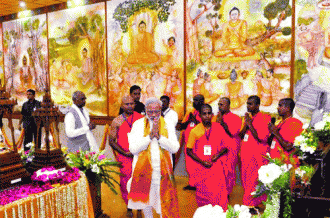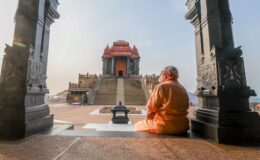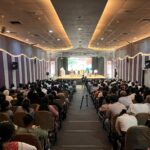DIALOGUE THAT ENLIGHTENS US ALL
- By : Anirban Ganguly
- Category : Articles

Prime Minister Modi’s Bodh Gaya initiative has made it clear that India’s objective is to activate its past civilisational linkages and to restructure them to the exigencies of the present, where it seeks to pursue a pragmatic foreign policy of multi-alignment and multi-engagement
It was in September 2015, that Prime Minister Narendra Modi initiated a wide and intricate outreach to countries that have been shaped by the ideals and legacy of Buddha. It will be interesting, thus, to once again look at that effort in the backdrop of the Lumbini conference this month. Through an international initiative on the theme of Samvad — Global Hindu-Buddhist Initiative on Conflict Avoidance and Environment Consciousness, hosted by the Vivekananda International Foundation, India, in collaboration with the International Buddhist Confederation, stated the aspiration to work for regional stability, prosperity and harmony based on the ancient Indic wisdom that worked to avoid conflict and to re-establish the balance between nature and mankind on a relation that was non-exploitative and based on mutual respect, admiration and yearnings for assimilation. As Modi described it, the conference “was conceptualised on shifting the paradigm from conflict resolution to conflict avoidance and from environmental regulation to environmental consciousness”.
It was in this conference that Modi first talked of ‘climate justice’ — to ensure which, each nation of the region inspired by the Indic philosophies, had to delve into their thought repositories and based on it, shape a framework of cooperation and joint action. He said, “I want to say that we, the present generation, have the responsibility to act as a trustee of the rich natural wealth for the future generations. The issue is not merely about climate change; it is about climate justice. Again, I repeat (it) is not the issue of climate change, it is about climate justice. In my view, the most adversely affected by climate change are the poor and the downtrodden. When a natural disaster strikes, they are hit the hardest. When there are floods, they are rendered homeless; during a quake, their homes are destroyed; during droughts, they are affected; and during extreme cold too, the homeless suffer the most. We can’t let climate change keep affecting people in this manner. Which is why I believe the discourse must shift focus from climate change to climate justice.”
On the need for the Samvad dialogue, Modi argued that the Indic wisdom — Hindu and Buddhist — could evolve a new mechanism of conflict-avoidance. Promotion of dialogue calls for a shift from ideological approach to a philosophic one. Without proper dialogue, neither of the two themes of conflict avoidance is possible, or workable. The severe limitations in our conflict resolution mechanisms are becoming more and more obvious. We need significant, collective and strategic efforts to prevent bloodshed and violence. It is, thus, no surprise that the world is taking note of Buddhism. This is also a recognition of the historical Asian traditions and values, which can be used to shift the paradigm to conflict avoidance, to move from the path of ideology to philosophy…All of us here have a cardinal duty to ensure that our future generations lead a life of peace, dignity and mutual respect. We need to sow the seeds of a conflict-free world and, in this endeavour; faiths of Buddhism and Hinduism have a great contribution.
This conference thus ideated the theme and objective of reaching out to the entire Southeast Asian region through the message of Buddha and the Indic philosophical corpus which had attracted this region over millennia and had enhanced its engagement with civilisational India. In fact, Modi clearly saw, “that without embracing the path and ideals shown by Gautam Buddha, this century cannot be an Asian century!”
In order to take the outreach further and give it a certain concrete momentum, Modi joined the entire international assemblage of thinkers, philosophers, monks, diplomats and practitioners in Bodh Gaya, mediated with them under the sacred Bodhi Tree and reiterated India’s timeless message of dialogue, harmonious living and reverence for nature and for the earth. Modi, in his valedictory address before the international gathering made a few significant points which need reiteration because these are closely identified with India’s soft power goals or civilisational belief.
“On the issue of conflicts — most of which are being driven by religious intolerance — the participants in the conference seem to have agreed that while there is no problem about the freedom to practice one’s religion, it is when the radical elements try to force their own ideologies on others, that the potential for conflict arises. On the issue of environment, the conference seems to have agreed that the philosophic underpinning of the Dharma, which stresses the protection of natural heritage, is critical for sustainable development. I may add that the United Nations too has arrived at the view that sustainable development is achievable only through aligning development to the local culture of the people.”
But perhaps the most significant aspect of this entire soft exercise was the release of the Bodh Gaya Declaration. Bodh Gaya was declared as the “seat of enlightenment for the world of Buddhism and Buddhist civilisation that have inspired all religions of the world”. The declaration, with the Prime Minister’s sanction, stated that “a Buddhist spiritual and civilisational institution that will bring together and make the entire Buddhist world participate in this momentous task will be built in Bodh Gaya in the coming three years”; that “Hindu civilisational and spiritual institutions will be invited to work with this new Buddhist institution to share the responsibility for global peace and harmony”; that “Buddhist spiritual leaders will approach Governments of all Buddhist nations to support this monumental and noble task of developing Bodh Gaya as an International Centre of Buddhism for the enlightenment of all humankind”. It called upon India to provide support for creating such a vibrant centre of civilisational cooperation.
The very spot where Siddhartha transformed into Shakyamuni thus holds the potential to elevate itself into a radiating power house of light and knowledge and as in the ancient times, like a lighthouse attract civilisations from across the globe. With a rising and renewed interest in Indian traditions and knowledge systems across the world, with the launching of the Indic and Buddhist Studies University at Sanchi in Madhya Pradesh — an effort that has silently taken shape away from the glare of false propaganda — India can develop a formidably vibrant Buddhist circuit of knowledge, experience and practice. It can evolve into a circuit that will make India, once again, the centre of Buddhist thought and a genuine repository of Shakyamuni’s legacy. India’s image as a benefactor and promoter of knowledge and as a power with profound regard for local knowledge systems and ways of living can go a long way in further strengthening this web of Indic and Buddhist knowledge across countries and institutions and create the civilisational spiritual highway.
The Bodh Gaya initiative was an expression of the innovation that has permeated India’s soft power engagement and diplomacy ever since Prime Minister Modi took over. India’s objective in these two intervening years has been to activate its past civilisational linkages and to re-state and re-structure them to the exigencies of the present where India seeks to pursue a pragmatic foreign policy of multi-alignment and multi-engagement, through which it seeks a genuine and co-equal partnership with those nations and civilisations that had great affinity and proximity to it in the past. The vision that the Bodh Gaya Declaration articulated may thus begin to be worked out with determination and vision.

















